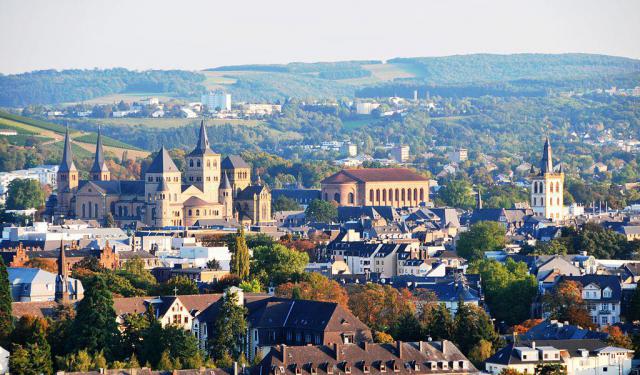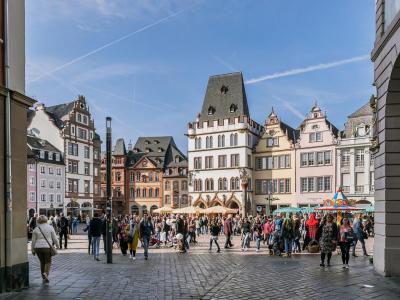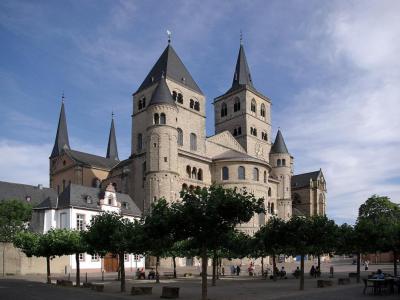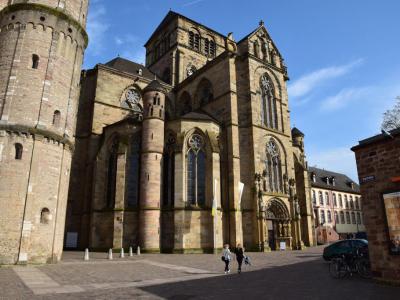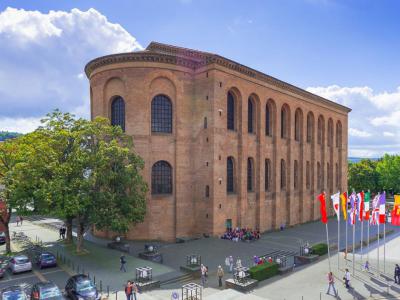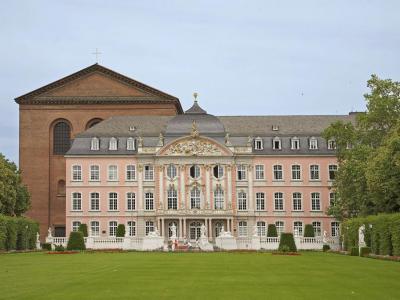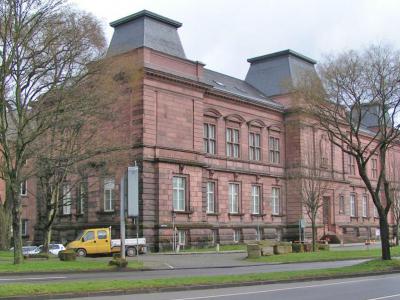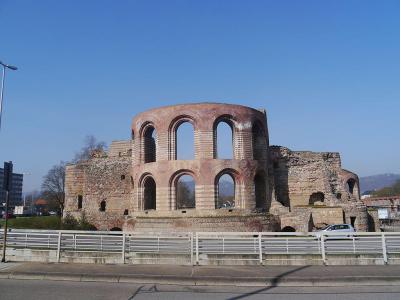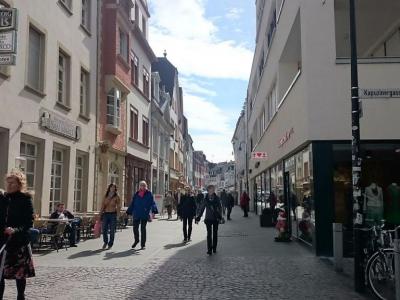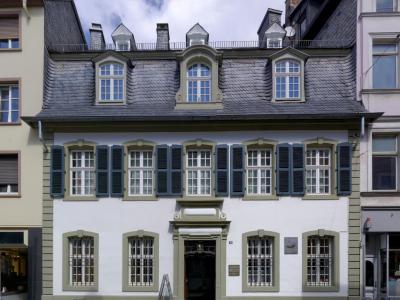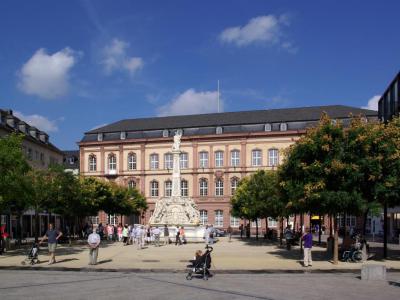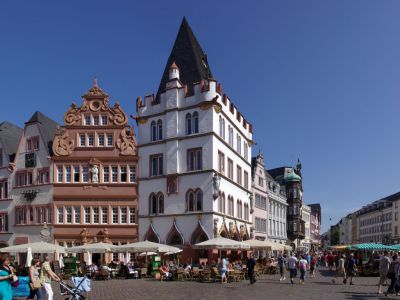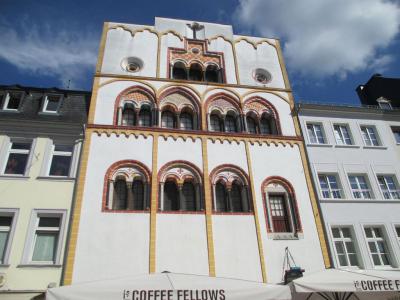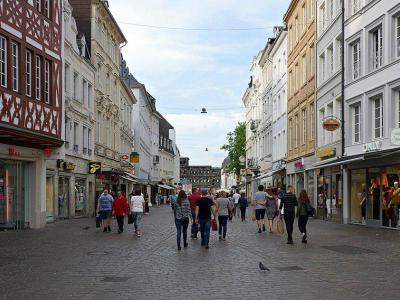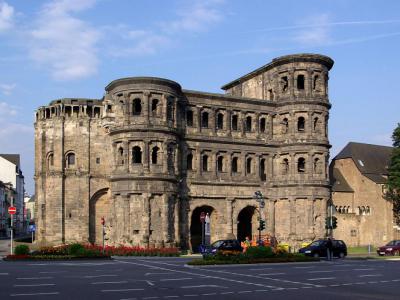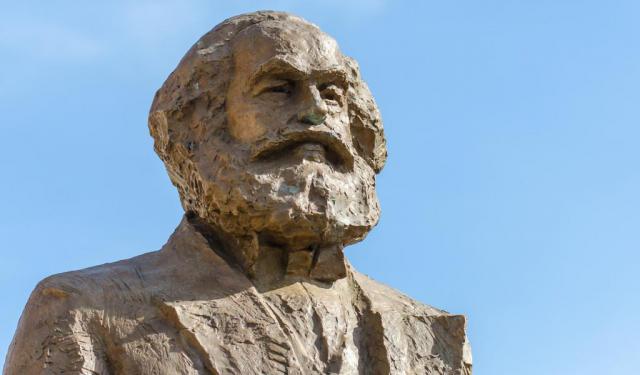Trier Introduction Walking Tour (Self Guided), Trier
Trier is Germany’s oldest city and features beautiful Roman ruins, impressive medieval architecture, stunning churches, and fascinating museums.
While an inscription on the famous Red House states that the city was founded 1300 years before the Romans arrived, this has never been proven. The Celtics originally founded Trier during the fourth century BC. The Romans arrived in the first century BC and built Trier into a bustling Roman city that became one of the Roman Empire’s four capitals. During the fourth century, up to 100,000 Romans lived in Trier.
Roman history is prominently displayed in Trier. Visitors can admire the massive Roman Black Gate and walk through the Imperial Roman Baths. The Basilica of Constantine is well-preserved and is the largest Roman structure outside of Rome.
During the Middle Ages, Trier’s archbishop-elector was one of the Holy Roman Empire’s seven electors and held tremendous power. Trier became an important center of early Christianity and is home to several historic churches, including St. Peter’s Cathedral and the Church of Our Lady. Both churches were built on the site of a Roman palace, and St. Peter’s is Germany’s oldest church.
Epiphany House is a fabulous example of early Gothic architecture and dates to the 13th century. The Steipe House in Main Square is another beautifully restored building that dates to the 15th century.
Trier continued to prosper as an economic and cultural center until French invasions led to its decline during the 17th and 18th centuries. Napoleon Bonaparte conquered and occupied the city, which was ceded to France in 1801.
Prussia took control from 1805 to 1815. The city was heavily damaged during World War II but has been rebuilt as a cultural and commercial center.
Simeon Street is Trier’s main shopping street, where visitors can enjoy Trier’s history, culture, and cuisine. Main Market Square features a cross dating to 958 and is surrounded by flowers, vibrant facades, and market stalls.
Visitors can explore the city’s history at the Rhineland Museum, which displays artifacts from Celtic times to modern times. Trier is also the birthplace and home town of Karl Marx, founder of communism. The Karl Marx House Museum is dedicated to the life and work of the arguably the most influential and controversial philosopher of the 19th century.
Take this self-guided waking tour to explore the former Roman Empire's northern capital and Trier’s most notable sights.
While an inscription on the famous Red House states that the city was founded 1300 years before the Romans arrived, this has never been proven. The Celtics originally founded Trier during the fourth century BC. The Romans arrived in the first century BC and built Trier into a bustling Roman city that became one of the Roman Empire’s four capitals. During the fourth century, up to 100,000 Romans lived in Trier.
Roman history is prominently displayed in Trier. Visitors can admire the massive Roman Black Gate and walk through the Imperial Roman Baths. The Basilica of Constantine is well-preserved and is the largest Roman structure outside of Rome.
During the Middle Ages, Trier’s archbishop-elector was one of the Holy Roman Empire’s seven electors and held tremendous power. Trier became an important center of early Christianity and is home to several historic churches, including St. Peter’s Cathedral and the Church of Our Lady. Both churches were built on the site of a Roman palace, and St. Peter’s is Germany’s oldest church.
Epiphany House is a fabulous example of early Gothic architecture and dates to the 13th century. The Steipe House in Main Square is another beautifully restored building that dates to the 15th century.
Trier continued to prosper as an economic and cultural center until French invasions led to its decline during the 17th and 18th centuries. Napoleon Bonaparte conquered and occupied the city, which was ceded to France in 1801.
Prussia took control from 1805 to 1815. The city was heavily damaged during World War II but has been rebuilt as a cultural and commercial center.
Simeon Street is Trier’s main shopping street, where visitors can enjoy Trier’s history, culture, and cuisine. Main Market Square features a cross dating to 958 and is surrounded by flowers, vibrant facades, and market stalls.
Visitors can explore the city’s history at the Rhineland Museum, which displays artifacts from Celtic times to modern times. Trier is also the birthplace and home town of Karl Marx, founder of communism. The Karl Marx House Museum is dedicated to the life and work of the arguably the most influential and controversial philosopher of the 19th century.
Take this self-guided waking tour to explore the former Roman Empire's northern capital and Trier’s most notable sights.
How it works: Download the app "GPSmyCity: Walks in 1K+ Cities" from Apple App Store or Google Play Store to your mobile phone or tablet. The app turns your mobile device into a personal tour guide and its built-in GPS navigation functions guide you from one tour stop to next. The app works offline, so no data plan is needed when traveling abroad.
Trier Introduction Walking Tour Map
Guide Name: Trier Introduction Walking Tour
Guide Location: Germany » Trier (See other walking tours in Trier)
Guide Type: Self-guided Walking Tour (Sightseeing)
# of Attractions: 14
Tour Duration: 2 Hour(s)
Travel Distance: 3.5 Km or 2.2 Miles
Author: alice
Sight(s) Featured in This Guide:
Guide Location: Germany » Trier (See other walking tours in Trier)
Guide Type: Self-guided Walking Tour (Sightseeing)
# of Attractions: 14
Tour Duration: 2 Hour(s)
Travel Distance: 3.5 Km or 2.2 Miles
Author: alice
Sight(s) Featured in This Guide:
- Hauptmarkt (Main Market Square)
- Trier Dom (St. Peter's Cathedral)
- Liebfrauenkirche (Church of Our Lady)
- Aula Palatina (Basilica of Constantine)
- Kurfürstliches Palais (Electoral Palace)
- Rheinisches Landesmuseum (Rhineland Museum)
- Kaiserthermen (Imperial Roman Baths)
- Neustrasse (New Street)
- Karl Marx House Museum
- Kornmarkt (Grain Market) and St. George's Fountain
- Steipe and Red Houses
- Dreikönigenhaus (Epiphany House)
- Semionstrasse (Semion Street)
- Porta Nigra (Black Gate)
1) Hauptmarkt (Main Market Square) (must see)
Main Market Square is the Trier's central square and one of its largest squares. Main Market Square has been a marketplace since the 10th century. Trier's main shopping streets meet here, and the square features many historic and landmark buildings.
Archbishop Heinrich I installed a cross in Main Market Square in 958. This ancient cross is one of Europe's oldest market crosses. It stands on an ancient Roman pillar, which served as a pillory. Visitors can see four holes where chains would have been attached to punish and humiliate law-breaking citizens publicly.
The cross features a Latin inscription, an image of the Lamb of God, and a victory banner. The sides of the cross have a sundial and a depiction of Saint Peter. The market cross is a replica, and the original cross is on display at the Simeonstift Municipal Museum.
The Petrusbrunnen fountain was created in 1594 by sculptor Hans Ruprecht Hoffman. A statue of Saint Peter stands at the top of the fountain, and representations of virtues stand around the fountain's base. The statues represent Fortitude, Temperance, Justice, and Wisdom. At the beginning of the Old Town Festival, residents add decorative lighting and a flower bouquet to the Saint Peter statue to ensure good holiday weather.
Main Market Square features historic houses from Renaissance, Baroque, and Classical periods, including the Steipe and Red Houses.
Visitors can access the Church of Saint Gangolf through the square. In addition, the square is an entrance point to the city's former Jewish quarter.
Main Market Square hosts several events and festivals throughout the year. For example, visitors might catch the Street Festival, the Old Town Festival, the Christmas Market, a New Year's Run, or the Corpus Christi Procession.
Archbishop Heinrich I installed a cross in Main Market Square in 958. This ancient cross is one of Europe's oldest market crosses. It stands on an ancient Roman pillar, which served as a pillory. Visitors can see four holes where chains would have been attached to punish and humiliate law-breaking citizens publicly.
The cross features a Latin inscription, an image of the Lamb of God, and a victory banner. The sides of the cross have a sundial and a depiction of Saint Peter. The market cross is a replica, and the original cross is on display at the Simeonstift Municipal Museum.
The Petrusbrunnen fountain was created in 1594 by sculptor Hans Ruprecht Hoffman. A statue of Saint Peter stands at the top of the fountain, and representations of virtues stand around the fountain's base. The statues represent Fortitude, Temperance, Justice, and Wisdom. At the beginning of the Old Town Festival, residents add decorative lighting and a flower bouquet to the Saint Peter statue to ensure good holiday weather.
Main Market Square features historic houses from Renaissance, Baroque, and Classical periods, including the Steipe and Red Houses.
Visitors can access the Church of Saint Gangolf through the square. In addition, the square is an entrance point to the city's former Jewish quarter.
Main Market Square hosts several events and festivals throughout the year. For example, visitors might catch the Street Festival, the Old Town Festival, the Christmas Market, a New Year's Run, or the Corpus Christi Procession.
2) Trier Dom (St. Peter's Cathedral) (must see)
Saint Peter's Cathedral is Germany's oldest church and Trier's oldest building still serving its original purpose. The cathedral is a UNESCO World Heritage Site.
It is thought that Emperor Constantine the Great commissioned the cathedral and built it on top of a Roman palace. The next-door Church of Our Lady was also built on top of the original Roman complex.
Bishop Maximin oversaw the cathedral's construction in the fourth century. This impressive cathedral was four times the size of the current cathedral and features four basilicas.
Parts of the present-day church's brick walls and piers are from the original cathedral. The cathedral has been damaged and rebuilt several times over the centuries. Saint Peter's Cathedral is mainly Romanesque but features Gothic vaults, Baroque chapels, and Renaissance sculptures.
Visitors will find Roman brickwork on the north facade. The cathedral's stunning west facade was built in the 11th century. The Chapel of the Holy Robe was added to the east choir in the 18th century.
There is a Latin inscription above the tallest tower's clock. The inscription can be translated as "You do not know what time the Lord is coming."
The interior features three Romanesque naves with Gothic vaults. Four original Roman columns have been transformed into cruciform piers.
The invaluable Holy Robe is featured in a Baroque chapel. The relic is thought to be the robe Jesus wore during his crucifixion, and Saint Helena discovered the relic in the fourth century. Since 1512, the cathedral has held irregular pilgrimages to allow the faithful to view the Holy Robe. The last pilgrimage was held in 2012.
It is thought that Emperor Constantine the Great commissioned the cathedral and built it on top of a Roman palace. The next-door Church of Our Lady was also built on top of the original Roman complex.
Bishop Maximin oversaw the cathedral's construction in the fourth century. This impressive cathedral was four times the size of the current cathedral and features four basilicas.
Parts of the present-day church's brick walls and piers are from the original cathedral. The cathedral has been damaged and rebuilt several times over the centuries. Saint Peter's Cathedral is mainly Romanesque but features Gothic vaults, Baroque chapels, and Renaissance sculptures.
Visitors will find Roman brickwork on the north facade. The cathedral's stunning west facade was built in the 11th century. The Chapel of the Holy Robe was added to the east choir in the 18th century.
There is a Latin inscription above the tallest tower's clock. The inscription can be translated as "You do not know what time the Lord is coming."
The interior features three Romanesque naves with Gothic vaults. Four original Roman columns have been transformed into cruciform piers.
The invaluable Holy Robe is featured in a Baroque chapel. The relic is thought to be the robe Jesus wore during his crucifixion, and Saint Helena discovered the relic in the fourth century. Since 1512, the cathedral has held irregular pilgrimages to allow the faithful to view the Holy Robe. The last pilgrimage was held in 2012.
3) Liebfrauenkirche (Church of Our Lady) (must see)
The Church of Our Lady (Liebfrauenkirche) in Trier is a remarkable example of French High Gothic architecture outside of France. Recognized by UNESCO as part of the Roman Monuments, Cathedral of Saint Peter, and Church of Our Lady in Trier World Heritage Site, this church stands next to the Trier Cathedral, sharing a wall and cloister with it. Originally, a Roman double church occupied this site, initiated by a large endowment from Roman Emperor Constantine in 326 AD. By the early 13th century, the southern part had fallen into disrepair, prompting Archbishop Theoderich von Wied to commission French builders from Champagne to reconstruct it. Construction likely began in 1230, and the church was completed around 1260.
The Church of Our Lady’s design is unique, featuring a cruciform floor plan shaped like a rose, symbolizing the Virgin Mary as the Rosa Mystica. This rose design includes twelve "petals," representing the twelve tribes of Israel and the Twelve Apostles. Supporting columns are decorated with paintings of the apostles and the articles of the Apostles' Creed, which can only be fully appreciated from a spot marked by a golden star.
Historically, the church has undergone significant transformations. In 1492, a peak known for its impressive craftsmanship crowned the central tower but was destroyed in a 1631 storm. Later, the roof was replaced in 1945 and again, with a steeper version, in 2003. Designated a minor basilica by Pope Pius XII in 1951, this church holds a deep architectural and spiritual significance. Today, it stands as a Gothic masterpiece with ancient roots, supported by Roman column foundations beneath the structure.
The Church of Our Lady’s design is unique, featuring a cruciform floor plan shaped like a rose, symbolizing the Virgin Mary as the Rosa Mystica. This rose design includes twelve "petals," representing the twelve tribes of Israel and the Twelve Apostles. Supporting columns are decorated with paintings of the apostles and the articles of the Apostles' Creed, which can only be fully appreciated from a spot marked by a golden star.
Historically, the church has undergone significant transformations. In 1492, a peak known for its impressive craftsmanship crowned the central tower but was destroyed in a 1631 storm. Later, the roof was replaced in 1945 and again, with a steeper version, in 2003. Designated a minor basilica by Pope Pius XII in 1951, this church holds a deep architectural and spiritual significance. Today, it stands as a Gothic masterpiece with ancient roots, supported by Roman column foundations beneath the structure.
4) Aula Palatina (Basilica of Constantine) (must see)
The Basilica of Constantine is a Roman palace basilica that was originally built between AD 300 and AD 310. It currently houses the Church of Our Redeemer and is part of Trier's UNESCO World Heritage Site.
The Basilica of Constantine was originally part of a complex, not the stand-alone building it is today. The basilica was constructed in solid brick with black and white marble floors and an impressive floor and wall heating system.
The Bishop of Trier used the building as his residence during the Middle Ages. The basilica was incorporated into the archbishop Lothar von Metternich's palace during the 17th century. During the 19th century, Frederick William IV of Prussia restored the building to its Roman state.
The Basilica became a Protestant Church in 1856. It was rebuilt after being damaged during World War II. Restorers didn't replace the inner decorations, so visitors can see the brick walls from the inside.
The Basilica of Constantine is an impressively large building at 33 meters high (108 feet) and 67 meters long (220 feet). The basilica's windows create an optical illusion that makes the building look even bigger than it is.
Excavation work underneath the basilica has been preserved, and visitors can take a guided tour to view the underground Roman area. The basilica also hosts several inspirational concerts every year.
The Basilica of Constantine was originally part of a complex, not the stand-alone building it is today. The basilica was constructed in solid brick with black and white marble floors and an impressive floor and wall heating system.
The Bishop of Trier used the building as his residence during the Middle Ages. The basilica was incorporated into the archbishop Lothar von Metternich's palace during the 17th century. During the 19th century, Frederick William IV of Prussia restored the building to its Roman state.
The Basilica became a Protestant Church in 1856. It was rebuilt after being damaged during World War II. Restorers didn't replace the inner decorations, so visitors can see the brick walls from the inside.
The Basilica of Constantine is an impressively large building at 33 meters high (108 feet) and 67 meters long (220 feet). The basilica's windows create an optical illusion that makes the building look even bigger than it is.
Excavation work underneath the basilica has been preserved, and visitors can take a guided tour to view the underground Roman area. The basilica also hosts several inspirational concerts every year.
5) Kurfürstliches Palais (Electoral Palace)
The Electoral Palace was built on the site of the old Roman area and is next door to the Basilica of Constantine. The Electoral Palace was built between 1615 and 1676 and is one of the world's most beautiful examples of a Rococo palace.
At the end of the 16th century, archbishop Johann von Schönenberg planned to build a Renaissance-style palace here. Electoral Prince Lothar von Metternich began construction on the lower palace, which was completed around 1650. The Petersburg Portal dates to the 1620s, and the Red Tower was completed in 1647. Construction on the upper palace stalled during the Thirty Years' War.
In the mid-18th century, Archbishop-Elector Johann IX Philipp von Walderdorff built the south wing in the Rococo style and added Baroque gardens.
The Trier Electoral Princes used the palace as a residence until 1794 when French revolutionary forces captured the palace and used it as a barracks. When the Basilica of Constantine was renovated in 1850, the palace's west wing was demolished. However, the south wing was preserved with its beautiful interior and impressive staircase.
The palace was damaged during World War II. Today, the Grand Chamber in the Rococo south wing hosts classical music concerts. The palace gardens are open to the public and feature a large pond and several beautiful statues.
At the end of the 16th century, archbishop Johann von Schönenberg planned to build a Renaissance-style palace here. Electoral Prince Lothar von Metternich began construction on the lower palace, which was completed around 1650. The Petersburg Portal dates to the 1620s, and the Red Tower was completed in 1647. Construction on the upper palace stalled during the Thirty Years' War.
In the mid-18th century, Archbishop-Elector Johann IX Philipp von Walderdorff built the south wing in the Rococo style and added Baroque gardens.
The Trier Electoral Princes used the palace as a residence until 1794 when French revolutionary forces captured the palace and used it as a barracks. When the Basilica of Constantine was renovated in 1850, the palace's west wing was demolished. However, the south wing was preserved with its beautiful interior and impressive staircase.
The palace was damaged during World War II. Today, the Grand Chamber in the Rococo south wing hosts classical music concerts. The palace gardens are open to the public and feature a large pond and several beautiful statues.
6) Rheinisches Landesmuseum (Rhineland Museum) (must see)
Rhineland Museum focuses on Trier's impressive archeology. Exhibits show artifacts from the Stone Age, the Roman era, the Middle Ages, and more modern times.
Visitors can see ancient tools, jewelry, and weapons in the Stone Age exhibit. One of the most remarkable displays features the Trassem gold hoard from 1600 BC. Many of the other items are from the Celtic area.
The museum has an impressive collection of Roman sculptures. A replica of the 30-meter tall (98-feet) Igel Column is located in the courtyard. One of the exhibit rooms is dedicated to Roman-era grave monuments, including the Neumagen Wine Ship monument. Many Roman frescoes and detailed mosaics are also on display.
The Roman section includes a scale model of Trier in Roman times. Trier functioned as the Empire's northern capital, and archeologists have unearthed an impressive collection of Roman artifacts, including the largest Roman gold hoard ever discovered.
During the Middle Ages, Trier became an important Christian center. The Middle Ages exhibits include early Christian gravestones and several Romanesque sculptures. The Modern Era exhibit has an impressive reconstruction of a Christoph von Rheineck's 1535 funeral monument.
Visitors can see ancient tools, jewelry, and weapons in the Stone Age exhibit. One of the most remarkable displays features the Trassem gold hoard from 1600 BC. Many of the other items are from the Celtic area.
The museum has an impressive collection of Roman sculptures. A replica of the 30-meter tall (98-feet) Igel Column is located in the courtyard. One of the exhibit rooms is dedicated to Roman-era grave monuments, including the Neumagen Wine Ship monument. Many Roman frescoes and detailed mosaics are also on display.
The Roman section includes a scale model of Trier in Roman times. Trier functioned as the Empire's northern capital, and archeologists have unearthed an impressive collection of Roman artifacts, including the largest Roman gold hoard ever discovered.
During the Middle Ages, Trier became an important Christian center. The Middle Ages exhibits include early Christian gravestones and several Romanesque sculptures. The Modern Era exhibit has an impressive reconstruction of a Christoph von Rheineck's 1535 funeral monument.
7) Kaiserthermen (Imperial Roman Baths) (must see)
The Imperial Roman Baths were constructed during Constantine I's reign in the fourth century. Trier's baths are the largest Roman baths outside of Rome. The original bathing structures were over 200 meters long (656 feet) and 100 meters wide (328 feet).
Constantine started building the baths as part of a city-wide building project. Trier was one of the Empire's most important cities and considered a "Second Rome." Roman Trier was home to between 75,000 and 100,000 people.
Bathing was an important part of Roman culture, and the baths were open to the public. The hot water pools reached 40 Celsius (104 Fahrenheit), and the complex had an underground tunnel system for staff. During the Middle Ages, the baths were turned into a castle. The baths have also been used as a city wall and a monastery.
Today's visitors can tour the baths and the underground passageways. The Imperial Roman Baths are part of Trier's UNESCO World Heritage Site.
Constantine started building the baths as part of a city-wide building project. Trier was one of the Empire's most important cities and considered a "Second Rome." Roman Trier was home to between 75,000 and 100,000 people.
Bathing was an important part of Roman culture, and the baths were open to the public. The hot water pools reached 40 Celsius (104 Fahrenheit), and the complex had an underground tunnel system for staff. During the Middle Ages, the baths were turned into a castle. The baths have also been used as a city wall and a monastery.
Today's visitors can tour the baths and the underground passageways. The Imperial Roman Baths are part of Trier's UNESCO World Heritage Site.
8) Neustrasse (New Street)
New Street is a wonderful shopping and cultural destination with a long history. New Street was built on the grounds of the ancient Roman Forum, which had a hall and marketplace, and was part of the city center. After the hall fell into disuse, a "new street" was built through the ruins.
Remnants of the hall's walls can be seen in some of New Street's cellars. During Medieval times, a city wall gate stood at the street's southern end. The street has been known as Nova Platea, or "New Street," since 1150.
After World War II bombs damaged many of New Street's buildings, the buildings were rebuilt and reorganized. Today, visitors will find 22 cultural monuments on New Street. For example, 23 New Street 23 dates to 1595 and features Gothic architecture. 42 Neustrasse dates to 1596 and has original Roman bricks in its cellar.
Visitors can walk New Street and check out various shops, restaurants, cafes, and galleries. Shoppers will find designer clothing, jewelry, ceramics, books, and more. At the Gallery Network, visitors will find exhibitions, a beautiful garden, and events such as concerts, lectures, and readings.
Remnants of the hall's walls can be seen in some of New Street's cellars. During Medieval times, a city wall gate stood at the street's southern end. The street has been known as Nova Platea, or "New Street," since 1150.
After World War II bombs damaged many of New Street's buildings, the buildings were rebuilt and reorganized. Today, visitors will find 22 cultural monuments on New Street. For example, 23 New Street 23 dates to 1595 and features Gothic architecture. 42 Neustrasse dates to 1596 and has original Roman bricks in its cellar.
Visitors can walk New Street and check out various shops, restaurants, cafes, and galleries. Shoppers will find designer clothing, jewelry, ceramics, books, and more. At the Gallery Network, visitors will find exhibitions, a beautiful garden, and events such as concerts, lectures, and readings.
9) Karl Marx House Museum
Influential philosopher Karl Marx was born in this house in 1818. He would become the father of Marxism, laying the groundwork for communism and socialism. The museum hosts exhibits about Karl Marx's life, works, and influence.
The house was originally built in 1727 and has been renovated many times over the years. The building has been dedicated to remembering Karl Marx since 1947. The exhibits were revamped in 2018 to celebrate the 200th anniversary of Karl Marx's birth. The exhibits include a Marx bust sculpted by Marx's great-grandson and a first edition print of the pivotal Das Kapital.
Visitors can explore Marx's origins, family life, career, and time in exile in London. The ground floor focuses on Marx's life and family. The top floor looks at his sociology, economics, journalism, and philosophy work. The final portion of the museum reviews Marx's influence on the labor movement and the influence Marx's ideas had on the world.
Visitors will find various historical documents, photographs, and Marx's favorite armchair on display. In addition to the exhibits, the house features a beautiful garden with several sculptures depicting Karl Marx.
The house was originally built in 1727 and has been renovated many times over the years. The building has been dedicated to remembering Karl Marx since 1947. The exhibits were revamped in 2018 to celebrate the 200th anniversary of Karl Marx's birth. The exhibits include a Marx bust sculpted by Marx's great-grandson and a first edition print of the pivotal Das Kapital.
Visitors can explore Marx's origins, family life, career, and time in exile in London. The ground floor focuses on Marx's life and family. The top floor looks at his sociology, economics, journalism, and philosophy work. The final portion of the museum reviews Marx's influence on the labor movement and the influence Marx's ideas had on the world.
Visitors will find various historical documents, photographs, and Marx's favorite armchair on display. In addition to the exhibits, the house features a beautiful garden with several sculptures depicting Karl Marx.
10) Kornmarkt (Grain Market) and St. George's Fountain
The Grain Market square was originally laid out in 1746. Grain merchants had to offer their goods for sale in the city before the grain could be distributed further. The square's town hall had an open ground floor that was used as a marketplace.
One of the square's main attractions is the neoclassical casino. The casino was a gathering place for influential residents, including Karl Marx's father, Heinrich Marx. The casino was damaged during World War II but rebuilt in the 1950s.
Saint George's Fountain on the square is considered one of Germany's most beautiful fountains. It was built in Rococo style by court architect Johannes Seiz. The 11-meter tall (36-foot) fountain features a statue of Saint George and represents the four seasons.
In 2003, the square was redesigned and paved with granite slabs. The square's magnificent cedar tree was scheduled to be cut down during the redesign. However, residents successfully petitioned to save it. The square's main attraction is its fabulous restaurants and cafes.
The Grain Market square hosts the Trier Old Town Festival and Christopher Street Day.
One of the square's main attractions is the neoclassical casino. The casino was a gathering place for influential residents, including Karl Marx's father, Heinrich Marx. The casino was damaged during World War II but rebuilt in the 1950s.
Saint George's Fountain on the square is considered one of Germany's most beautiful fountains. It was built in Rococo style by court architect Johannes Seiz. The 11-meter tall (36-foot) fountain features a statue of Saint George and represents the four seasons.
In 2003, the square was redesigned and paved with granite slabs. The square's magnificent cedar tree was scheduled to be cut down during the redesign. However, residents successfully petitioned to save it. The square's main attraction is its fabulous restaurants and cafes.
The Grain Market square hosts the Trier Old Town Festival and Christopher Street Day.
11) Steipe and Red Houses
The Steipe and Red Houses in Trier’s Main Market Square are architectural icons that showcase the city’s resilience and rich historical identity. The Steipe House, built in 1483, served as a venue for hosting dignitaries and city council members, reflecting Trier’s power and pride. The building’s name, "Steipe," comes from its distinctive arcade supports, adorned with sculptures of saints. Today, these statues are replicas, with the originals preserved at the City Museum Simeonstift. Damaged heavily during World War II, the Steipe was rebuilt in the 1970s in the original Late-Gothic style, a project funded entirely by the people of Trier, who raised 105,200 Marks in just six months. The faithful reconstruction reflects not only architectural heritage but also civic pride, reinforced by its grand merlons and symbolic knight statues-one knight eyeing the marketplace and the other gazing intently at the cathedral, hand on his sword.
Nearby, the Red House tells its tale of Trier’s storied past. Built in 1684 as the residence of Johann Wilhelm Polch, the cathedral secretary, it bears an inscription that proclaims Trier’s founding 1300 years before the Romans-a legend dating back to the Trier Episcopal Chronicle. While few in the 17th century took this seriously, the inscription served as a comforting affirmation of Trier’s ancient roots during a period marked by conflict and population decline. Today, the Red House, adorned with a statue of Saint Anthony, is home to a charming cafe where visitors can savor the layered history and local pride embedded in this historic corner of Trier.
Nearby, the Red House tells its tale of Trier’s storied past. Built in 1684 as the residence of Johann Wilhelm Polch, the cathedral secretary, it bears an inscription that proclaims Trier’s founding 1300 years before the Romans-a legend dating back to the Trier Episcopal Chronicle. While few in the 17th century took this seriously, the inscription served as a comforting affirmation of Trier’s ancient roots during a period marked by conflict and population decline. Today, the Red House, adorned with a statue of Saint Anthony, is home to a charming cafe where visitors can savor the layered history and local pride embedded in this historic corner of Trier.
12) Dreikönigenhaus (Epiphany House)
Epiphany House is an early Gothic residential tower and was completed in 1231. It is also known as the House of the Three Magi or the House of the Three Kings. The name comes from a painting representing the Epiphany that hung in the building's interior. In 1680, Johann Cornet ran "The Three Kings Inn" in this building.
This imposing house features a stark white facade with gold embellishments. The Ephinany House has ornate marble columns framing each window. Originally, the house was accessed through an upper level by a retractable ladder. This system provided safety in case of an attack. Trier probably had around ten such fortified houses, which were owned by influential and wealthy citizens.
The house was originally two separate front and back buildings, but the buildings are now connected with a staircase. Epiphany House has had several renovations throughout the centuries. The roof dates to 1696, and the building was renovated in 1938. An additional 1973 renovation sought to return the building to its original Medieval look. Today, the historic house hosts a cafe.
This imposing house features a stark white facade with gold embellishments. The Ephinany House has ornate marble columns framing each window. Originally, the house was accessed through an upper level by a retractable ladder. This system provided safety in case of an attack. Trier probably had around ten such fortified houses, which were owned by influential and wealthy citizens.
The house was originally two separate front and back buildings, but the buildings are now connected with a staircase. Epiphany House has had several renovations throughout the centuries. The roof dates to 1696, and the building was renovated in 1938. An additional 1973 renovation sought to return the building to its original Medieval look. Today, the historic house hosts a cafe.
13) Semionstrasse (Semion Street)
Semion Street is Trier's main shopping street and is pedestrian-only. The street was named after Simeon von Trier, who lived in the city's Roman era Black Gate in the 11th century. Saint Simeon of Trier was a monk and a hermit who died in Germany in 1035. He is venerated as a saint in the Eastern Orthodox Church and Catholic Church in Germany.
In the Middle Ages, the Jewish Quarter adjoined Semion Street. Visitors can see a plaque detailing Jewish history in Trier.
Semion Street is a shopping destination with two department stores, restaurants, cafes, a bookstore, fashion retailers, and souvenir shops. Semion Street is one of Germany's busiest shopping streets, and shoppers can seek out international brands or check out local boutiques.
Semion Street features several historic buildings. Below the Karstadt building is a Medevial wine cellar that dates to around 1200. The famous House of the Christopher was named after a statue of Saint Christopher that is part of the facade. Semion Street is also home to the Karl Marx Childhood Home and the former Saint Nicholas Chapel.
In the Middle Ages, the Jewish Quarter adjoined Semion Street. Visitors can see a plaque detailing Jewish history in Trier.
Semion Street is a shopping destination with two department stores, restaurants, cafes, a bookstore, fashion retailers, and souvenir shops. Semion Street is one of Germany's busiest shopping streets, and shoppers can seek out international brands or check out local boutiques.
Semion Street features several historic buildings. Below the Karstadt building is a Medevial wine cellar that dates to around 1200. The famous House of the Christopher was named after a statue of Saint Christopher that is part of the facade. Semion Street is also home to the Karl Marx Childhood Home and the former Saint Nicholas Chapel.
14) Porta Nigra (Black Gate) (must see)
Black Gate is an ancient Roman city gate and the largest Roman gate north of the Alps. It is part of Trier's UNESCO World Heritage Site.
The Black Gate name originated in the Middle Ages and refers to the darkened stone color. The Roman gate was built after 170 AD and used as a town entrance for centuries. The gate was built with 7200 massive sandstone blocks that weigh as much as six tons and are held in place by iron clamps. The construction of the gate was never completed for unknown reasons. Black Gate guarded Trier's northern entrance and was one of four city gates.
During the Middle Ages, the other three gates fell into disuse, and their stones were used for other building projects. However, the Black Gate had important historical value as revered Greek monk Simeon's home. Simeon was a religious hermit who sought sanctuary in the Black Gate during the 11h century. The Black Gate was then turned into two churches. Monks used the upper church, and the lower church was available to the public.
Napoleon Bonaparte dissolved the church in 1802. Bonaparte wanted to tear down the structure, but residents convinced him to save it and restore it to its Roman origins.
Visitors can see the remains of Roman columns leading up to the gate. Black Gate is open to visitors, and during the summer, an actor portraying a Roman army officer leads tours. Visitors can climb to the gate's top for commanding views of Trier.
The Black Gate name originated in the Middle Ages and refers to the darkened stone color. The Roman gate was built after 170 AD and used as a town entrance for centuries. The gate was built with 7200 massive sandstone blocks that weigh as much as six tons and are held in place by iron clamps. The construction of the gate was never completed for unknown reasons. Black Gate guarded Trier's northern entrance and was one of four city gates.
During the Middle Ages, the other three gates fell into disuse, and their stones were used for other building projects. However, the Black Gate had important historical value as revered Greek monk Simeon's home. Simeon was a religious hermit who sought sanctuary in the Black Gate during the 11h century. The Black Gate was then turned into two churches. Monks used the upper church, and the lower church was available to the public.
Napoleon Bonaparte dissolved the church in 1802. Bonaparte wanted to tear down the structure, but residents convinced him to save it and restore it to its Roman origins.
Visitors can see the remains of Roman columns leading up to the gate. Black Gate is open to visitors, and during the summer, an actor portraying a Roman army officer leads tours. Visitors can climb to the gate's top for commanding views of Trier.
Walking Tours in Trier, Germany
Create Your Own Walk in Trier
Creating your own self-guided walk in Trier is easy and fun. Choose the city attractions that you want to see and a walk route map will be created just for you. You can even set your hotel as the start point of the walk.
In The Footsteps of Karl Marx
Apart from being a home to the largest number of Roman ruins outside Rome, Trier is also extremely popular with international tourists, especially those from China, as the hometown of Karl Marx.
Here, the father of socialism and one of the most important philosophers of the 19th century, who, as an adult, managed to change the course of the world's history, had spent the first 17 years of... view more
Tour Duration: 1 Hour(s)
Travel Distance: 1.6 Km or 1 Miles
Here, the father of socialism and one of the most important philosophers of the 19th century, who, as an adult, managed to change the course of the world's history, had spent the first 17 years of... view more
Tour Duration: 1 Hour(s)
Travel Distance: 1.6 Km or 1 Miles
Trier's Roman Ruins Walking Tour
Nowadays it sounds a bit weird that a small German town of Trier, some 20-minute drive from the Luxembourg border, was once the capital of the mighty Western Roman Empire. Still, "the second Rome", as the emperor Diocletian used to call it, today fully lives up to its former status.
Founded in 15 BC by the Roman emperor Octavian Augustus, this oldest city in Germany is a home to the... view more
Tour Duration: 2 Hour(s)
Travel Distance: 4.4 Km or 2.7 Miles
Founded in 15 BC by the Roman emperor Octavian Augustus, this oldest city in Germany is a home to the... view more
Tour Duration: 2 Hour(s)
Travel Distance: 4.4 Km or 2.7 Miles
The Most Popular Cities
/ view all
